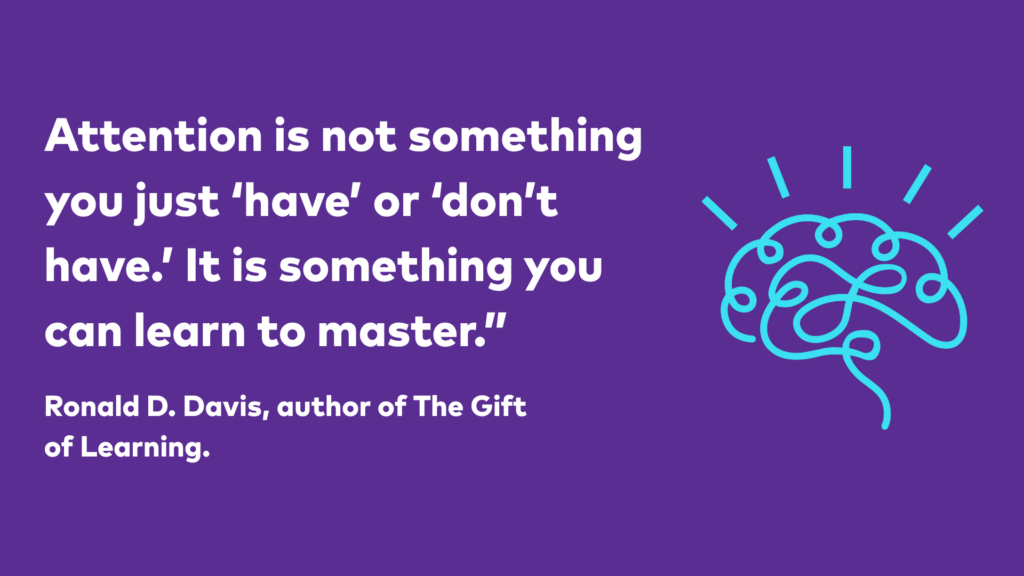

Attention Deficit Hyperactivity Disorder (ADHD) often makes focusing and maintaining order difficult. This blog explores the unique methods that Davis facilitators use to help individuals with ADHD manage their attention and create order in their environment and in life. It focuses on developing essential life skills through innovative techniques. These concepts are part of the Davis Method, a framework designed to empower individuals with ADHD and other neurotypes.

Orientation and disorientation are two different mental states that drastically impacts how we operate in our daily lives. Orientation is a mental state where perception matches what is actually happening in the environment and provides a sense of structure, focus, and control. This is the mental state where we’re able to be present, concentrate on a task, and tune out distractions. Disorientation, on the other hand, is a state of mental distraction, confusion, restlessness, but is also where daydreaming, problem-solving, and imagination can shine.
For example, a student in a classroom may experience disorientation if they’re bored or easily distracted by noises or sights around them, rather than being able to focus on the teacher’s lesson. Or someone with ADHD may find it challenging to maintain order and organization in their daily routines, which can make life feel chaotic and out of control.
Disorientation is not inherently good or bad – it’s simply a different way of processing information and experiencing the world. The Davis method recognizes that both orientation and disorientation are valuable life skills, depending on the situation and individual needs moment by moment.
This perspective challenges the traditional view of ADHD. Instead of labeling the state of disorientation as negative, the Davis method sees it as a useful skill. Orientation is necessary for tasks requiring precision. Disorientation, on the other hand, can spark creativity or exploration. The key is learning when and how to switch between these states.
The foundation of the Davis method is teaching individuals how to focus. There are three primary methods to guiding an individual to do this:
1. Visual thinkers: These individuals process information with mental images. Using visualization techniques, the Davis Orientation Counseling techniques enable clients to center their attention and focus quickly and easily.
2. Kinesthetic thinkers: These are physical, hands-on learners, such as athletes and artists. The Davis Alignment techniques use movement or physical sensations to stay focused.
3. Auditory thinkers: These individuals benefit from sounds, such as rhythmic beats or specific tones, to guide their focus. The Davis Auditory Orientation sound is highly effective to build focus endurance.
Teaching focus is simple. In most cases, it takes less than 30 minutes. After learning the techniques, individuals practice focusing and becoming more in-tune with the feeling of orientation. This includes noticing when they lose focus and working to regain it. Refocusing builds awareness and control over their attention.

ADHD often affects foundational life skills. Concepts such as time, order, sequence, and consequences may feel unclear. The Davis method introduces these ideas step by step. This process is like installing software in the mind. It fills in gaps that might exist and helps individuals understand key principles of how the world around them operates.
Here are some of the core life skills taught:
ADHD individuals often struggle to connect actions with outcomes. For example, the consequences of certain behaviors, like smoking or excessive drinking, may not appear until years later. This method teaches how to trace back events and identify the cause of unintended outcomes. By doing so, individuals are empowered to make better choices.
Order is more than keeping a tidy room. It involves organizing thoughts, actions, and time. The Davis method encourages practicing order in different ways:
Once individuals identify the cause of negative outcomes, they can explore alternatives. They are encouraged to test these new choices to see if they lead to better results. If the new choice still creates unintended consequences, they can refine it further. This trial-and-error process builds problem-solving skills and opens up new ways of doing things that will better serve them and those around them.
The Davis method offers a refreshing alternative to traditional ADHD interventions. Instead of aiming for constant focus, it embraces the natural rhythm of the mind. Disorientation is not viewed as a flaw but as a valuable state. This mindset fosters self-acceptance, confidence and encourages creativity.
By teaching practical tools and using real-world practice, this approach empowers individuals. They gain the skills needed to navigate challenges independently. The focus on life skills ensures lasting impact, far beyond the classroom or therapy session.
The ultimate goal of this method is to teach individuals how to manage their minds and environments. They learn to:
1. Recognize when they are focused or disoriented.
2. Switch between these states intentionally.
3. Maintain order in their thoughts, actions, and surroundings.
4. Analyze their choices and refine their actions.
By mastering these skills, individuals with ADHD can create a more balanced and fulfilling life. They gain control over their attention and can harness it to achieve their goals and potential. The Davis method provides the tools needed to thrive, one step at a time.